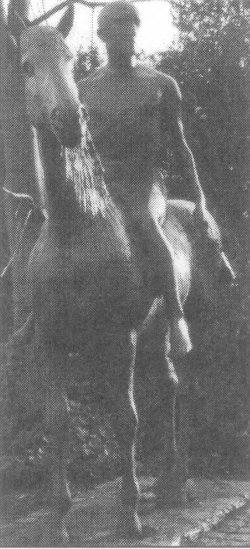Public Art in Winchester - TrustNews Spring 1999

Elizabeth Frink: 'Man on Horse',
Upper High Street
A few years ago there was displayed on the Inner Close of the Cathedral wire sculpture by Sophie Ryder. There were large boxing hares, a flock of sheep walking in line and horse rolling over and kicking its legs. The exhibition was very popular and those of us who live on the spot noticed with pleasure how people's expressions changed as they walked past the sculpture. However solemn or preoccupied they were at the outset, by the time they were leaving The Close many of them were smiling. This tells us how responsive people can be to public art and how it can affect our mood.
As we look about this great city' however, it is difficult to find many examples of sculpture or ceramics. We have the Frink Man on Horse in the High Street, King Alfred outside the Guildhall, The Soldier outside the Cathedral, and not much else. But consider the public spaces - Abbey Gardens, the Inner and Outer Closes, the forecourt of the County Court, the walls of many of our commercial and public buildings. What a difference the bright colours of ceramics or fine sculpture would make!
Visual art in towns and cities is important because beauty and meaning strengthen and elevate our lives and usually afford pleasure. Architecture should fulfil this function but we may question if such developments as the Brooks' Centre in fact do so. A tedious functionalism has affected much modern thinking about our towns and cities. Sculpture or ceramics in public places are for US all. If good artists create them and if the subject matter is such as to transform emotions that might be dispersed or darkened we will discover a civic influence that unifies the community, gives it identity and is a health-giving reality. In Rotterdam there stands Zadkine's To a Destroyed City (1953) which holds together the outrage the decimation by the Nazis of Rotterdam during World War II and the courage required to rebuild in 1945. Outside the UN Building in New York stands Barbara Hepworth's massive Single Form (1963), a modernist work full of grace and religious feeling, encouraging all that is best in human nature.
These are only great examples of what I mean. In a city like Winchester there is surely room for more carefully selected sculpture than we possess at present. We will be told that sculpture costs money and some may say it is unproductive. In quantitative terms I suppose that public art is useless but in deeper human and community terms it remains important to us all. Since tourism is emerging as a vital Winchester Industry it must be true that the more impressive our city looks the more magnetic it will be to potential visitors; but that apart may no rich citizen's be encouraged to consider the value of public sculpture and ceramics as memorials and gifts to the city'? May we not seek to emphasise 10% for art on any building project? Costs in building may thus include a 10% levy for adornment. Should not the City Council re-consider its duty in this respect?
As we look at the Cathedral or the Great Hall we see that our forebears cared for the quality of their buildings. Can we do less?
We are grateful to Rev. Canon K Walker, Cathedral Librarian, for his contribution
